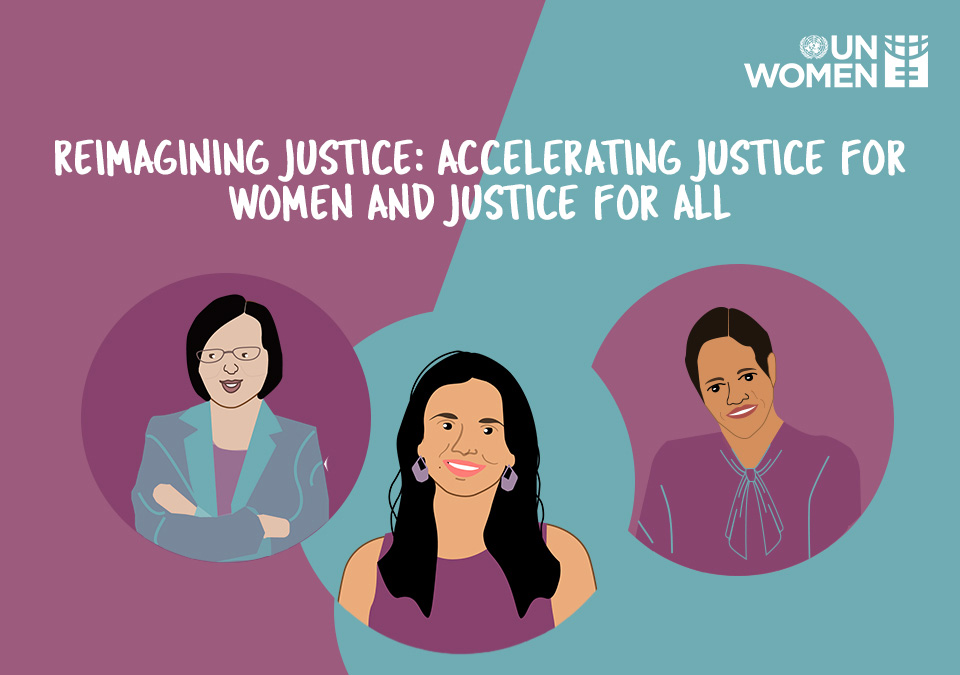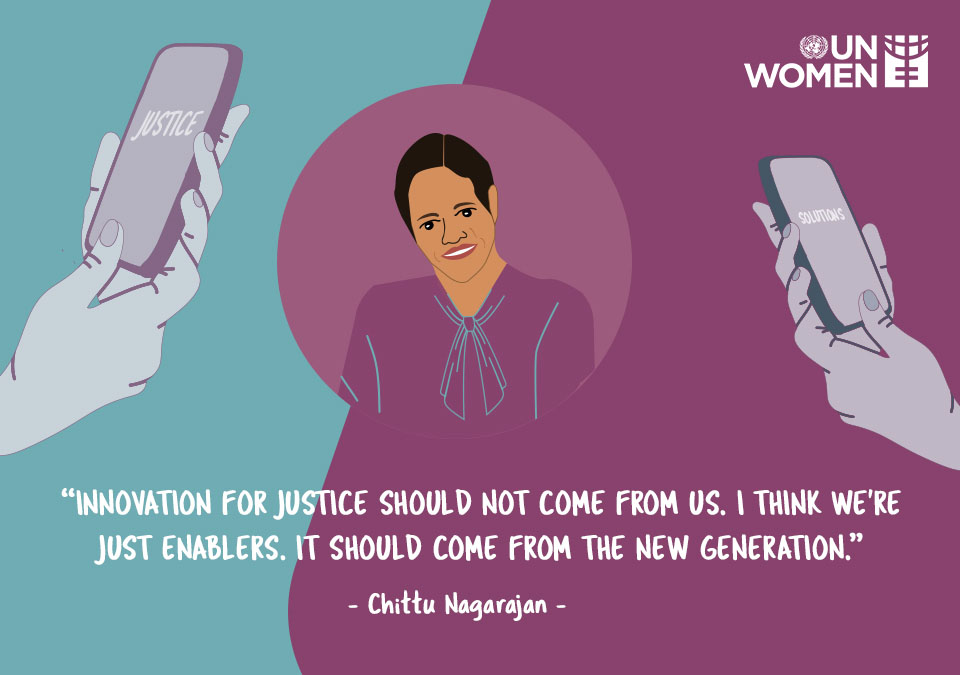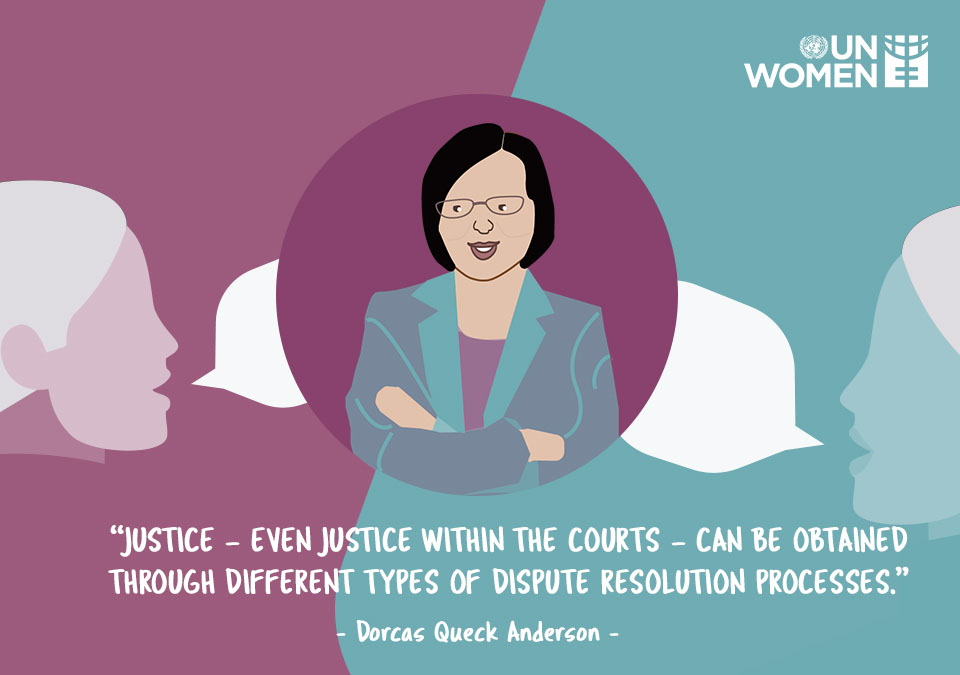Reimagining justice: Accelerating justice for women and justice for all
Date:
Author: Lauren Rooney

Meaningful justice is still out of reach for an estimated 5.1 billion people – two thirds of the world’s population.[1] Inequality and injustice go hand in hand, and women and marginalized groups are disproportionately disadvantaged in accessing justice, as they face unique social and institutional barriers.
Little progress has been made to close the justice gap, and justice experts, practitioners, rights defenders and activists across the globe are calling for innovative solutions to accelerate action to achieve justice for all by 2030.
Leading justice advocates and experts from across the region are driving innovative solutions to close the justice gap. The voices of three women justice experts show how to accelerate justice for women and justice for all – through trailblazing technological solutions, game-changing social entrepreneurship initiatives and gender-responsive mediation.
Technology: Trailblazing justice for the new generation

Chittu Nagarajan is a leading pioneer and entrepreneur in the online dispute resolution (ODR) sphere. She founded the first ODR service provider in India in 2004, ODRindia, and subsequently founded CREK ODR. She has used her experience in the ODR sphere to push forward innovative and accessible justice solutions and directly contribute to reimagining justice systems in India.
"When it comes to reimagining and transforming justice, ODR is the innovative form of alternative dispute resolution that everyone is talking about, especially after the COVID-19 pandemic. ODR uses technology to bring innovation into the justice field and increase access to justice,” explains Chittu.
The origins of ODR can be traced back to the 1990s when it was used to resolve e-commerce disputes online, however, over time it has been recognized as an effective mechanism and integrated into jurisdictions across the globe, including in India. ODR is ever-evolving and will continue to adapt to the latest technological innovations. That said, ODR in simple terms is the use of technology to resolve disputes outside of the public court system.[2]
"Using technology to increase access to justice goes beyond resolving disputes online and presents an opportunity for a people-centred approach to justice,” explains Chittu. “Technology can also allow individuals to enhance their legal literacy, know their options, find their solutions and ultimately have a voice in their own justice journey.”
"While we need to find solutions to address the gender digital divide, technology itself should not be a barrier. We do not need to invent a new form of technology, but we need to consider how we can leverage the tools we are comfortable using – such as our mobile phones – to access justice,” says Chittu.
In 2022, the number of smartphone users reached 6.6 billion worldwide, which translates to 83 per cent of the world's population, and by 2026, mobile device users will increase to 7.5 billion.[3] According to a GSM Association report, there is promising evidence that the widest mobile phone connectivity gender gaps are beginning to close. In South Asia, the mobile Internet gender gap has narrowed from 67 per cent in 2017 to 51 per cent in 2019, as another 78 million women gained Internet access.[4]
Looking to the future, Chittu says: “innovation for justice should not come from us. I think we're just enablers. It should come from the new generation. We must start thinking about how to empower them to leverage innovative technologies not only to access justice but as a means for them to design their own justice systems."
Mediation: A key to participative justice

Dorcas Queck Anderson is an Assistant Professor of Law at the Yong Pung How School of Law, in Singapore. Before joining the university, she was the assistant director of the Singapore Mediation Centre and practiced as a judge and mediator in the judiciary system in Singapore for seven years, including in the Supreme Court and the State Courts.
Dorcas’s justice journey has led her to become an advocate for mediation as an innovative solution to overcome barriers to justice. “Access to justice is very close to my heart. My journey started as a judge in the adversarial sphere, to embracing mediation as an alternative dispute resolution for justice,” says Dorcus. “For me, mediation gives people a voice.”
Mediation across the globe has had a key role in the development of the movement for access to justice.[5] “The growth of mediation coincided with perceived crises in the administration of justice in many countries,” explains Dorcas. “Mediation has transitioned through three different waves, and now the mediation process has emerged as a counterpoint to the litigation process amid a growing crisis of public trust in the courts.”
“The concept of mediation is not new,” says Dorcas. In Singapore, mediation is firmly embedded in the culture, dating back to traditional mediation practices where disputes were resolved at the communal level by respected elders – but the tradition eroded over time. Then, in the 1990s, the former Singapore Chief of Justice made efforts to reintroduce mediation into the justice system and promote mediation as an indigenous form of conciliatory justice. “This took reimagining justice, not as a foreign or unfamiliar concept, but a justice system which harkened back to our indigenous roots and that we could call our own,” she explains.
Dorcas has led mediation efforts for hundreds of civil and criminal cases, where she has witnessed first-hand the positive impact mediation has had in increasing accessibility and inclusive participation in justice systems. “Mediation can reduce the common barriers people face in accessing justice, including affordability, time, and access to information,” says Dorcas. “But mediation also offers the opportunity to have honest conversations about underlying interests within a safe space and to arrive at solutions that address deeper concerns, including wrongdoing. Such valuable outcomes cannot be achieved in the formal courtroom setting.”
“I see mediation playing a more active role in many countries’ justice system in the future. Many courts now offer mediation alongside the court adjudication services. This sends a strong message that justice – even justice within the courts – can be obtained through different types of dispute resolution processes,” says Dorcas.
Social entrepreneurship: A game-changer for justice

Kanan Dhru is a serial justice innovator. Over the past eight years, she has founded a series of innovative justice game-changers, including LawForMe, Lawtoons and Research Foundation for Governance. Today, she works as a Justice Innovation Advisor at the Hague Institute for Innovation of Law (HiiL), where she focuses on developing justice innovation insights, empowering justice innovators and strengthening the justice innovation ecosystem.
“We need to start looking at justice not only from the perspective of courts and lawyers but from the viewpoint of the person at the centre, whose problems we are addressing,” explains Kanan. “We must first understand directly what their needs are to be able to come up with solutions.”
HiiL conducts national surveys on justice needs and satisfaction across the world to reveals people’s actual legal problems, experiences and access to justice.[6]
“Over the past 12 years we have led the Innovative Justice Challenge initiative, which works with the public and private sector, entrepreneurs, start-ups and institutions to develop innovative justice pilots to address justice problems,” says Kanan. “These efforts have allowed us to gain insights into the kind of innovations that can become game-changers, which are the cutting edge of some of the most prominent ideas that we have seen work in the space of justice and delivery.”
“Now more than ever, we need the public and private sector, and other stakeholders to come together and continue innovating, designing and implementing game-changing ideas into scalable people-centred justice mechanisms across different countries,” says Kanan. “There is something interesting happening right now: we are at this threshold of bringing right-thinkers and stakeholders together for inclusive justice.”
Acknowledgements
These impact stories have been developed under the regional programme, entitled ‘Enhancing Access to Justice for Women in Asia and the Pacific: Bridging the gap between formal and informal systems through women’s empowerment and reduction of gender biases’, led jointly by UN Women, the International Commission of Jurists (ICJ) and the Office of the United Nations High Commissioner for Human Rights (OHCHR), and generously supported by the Swedish International Development Cooperation Agency (Sida).
Dorcas Queck Anderson and Chittu Nagarajan participated in the ‘Expert Roundtable: Justice for Women, Justice for All - Reimagine Justice,’ organized in partnership with UN Women, the United Nations Development Programme (UNDP) and Sida under the regional programme.